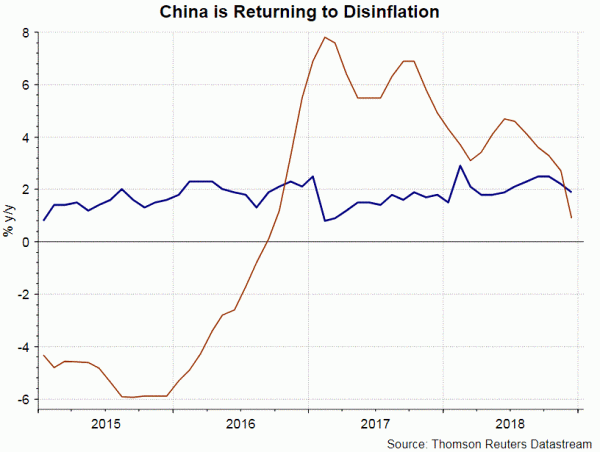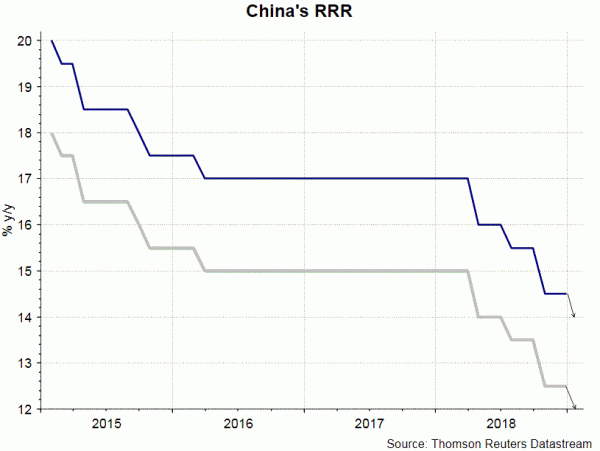PBOC has aggressively increased market liquidity. In the form of reverse repo operations, the central bank announced Wednesday that a total of RMB 570B would be pumped to the market. With RMB 10B of previous reverse repo maturing, the net injection would be RMB 560B. While the central bank noted that the move aims at accommodating taxpayers during the peak tax payment season, the liquidity injection is the highest on record for a single-day. Together with another RMB 700B injection after the RRR cut of -50 bps on January 15 (another one more of the same size on January 25), concerns about the growth slowdown in the world’s second largest economy have inevitably been intensified. While intensifying the stimulus efforts via reverse repo and RRR reduction, PBOC still refrains from cutting interest rates. We believe that policymakers are struggling to avoid entering a monetary easing. Although the Fed is expected to decelerate its rate hike path, it is still expected to have rate hikes this year, which balance sheet reduction remains in progress. A rate cut by PBOC would exacerbate policy divergence, potentially leading to abrupt capital outflow.
PBOC’s Reverse Repo Operations on Jan. 16
| Tenor | Volume | Interest Rate |
| 7-day | RMB 350 billion | 2.55% |
| 28-day | RMB 220 billion | 2.85% |
Besides monetary stimulus, the government has also pledged to increase fiscal stimulus, including huge tax cut and government spending. However, it could the wishful thinking of the government that fiscal stimulus could boost growth. Consumers are more likely to save than spend during economic slowdown. Meanwhile, issuance of government bonds in order to finance its expenditure could create a crowding-out effect. As the government is competing with corporate in acquiring funding, borrowing cost in general would increase, offsetting the stimulus implemented by the government with the aim of lowering interest rates.
As we are awaiting the 4Q18 GDP growth and other major macroeconomic data for December, all are due next week, the lately released inflation and credit data released have revealed that the country’s economy is not in good shape.
Inflation
Headline CPI eased, for a second consecutive month, to +1.9% y/y in December from +2.2% in November. Non-food inflation also decelerated for two months in a row +1.7%, as weak oil prices dampened transportation inflation. Food prices steadies at +2.5%, in which pork prices slipped to +1.5%. Core inflation steadied at +1.8% but has been getting weaker over the past year. PPI plunged significantly to +0.9%, from +2.7% in November. This is the lowest reading since September 2016. Continuous moderation in growth, weakness in oil prices and lower price pressure on imports due to recovery in renminbi suggest that risk to inflation is skewed to the downside. Upside surprise due to Lunar New Year should prove short-lived.
Credit Situation
The December report suggests that the credit situation improved in China. New renminbi loans were at RMB 1080B. While dropping from November’s RMB 1250B, it came in stronger than consensus of RMB 825B and jumped 84.9% from the same period last year. Contributing to the strong annual growth were corporate bills, short-term household and corporate loans. Yet, long-term loans remain weak with loans to households slipping to RMB 308B from RMB 311B a year ago, and corporate lending easing to RMB 198B from last December’s RMB 206B.
Total social financing (TSF) increased modestly to RMB 1590B, compared with RMB 1519B in November and RMB 1586B in last December. Yet, the reading was much stronger than consensus of RMB 1200B. looking into details, off-balance sheet contracted by a significant +10.8%. The pace of contraction has been accelerated. On a positive note, decline in off-balance sheet helps reduce the non-transparent channels of loans, thanks to the government’s efforts in deleverging. On the flip side, it has removed some credit channels which were popular among private companies in China.
Next week, China would its GDP growth for 4Q18, as well as industrial production, retail sales and fixed investment data for December. the market expects growth had decelerated to +6.4%. For this year, the IMF expects China’s economic growth would slow to +6.2% in 2019, down from previous forecast of +6.4%. Similarly, the World Bank projects that GDP would expand +6.5% this year, down from +6.8% in 2018. The Chinese government would likely revise lower its growth target to 6-6.5%, form “around 6.5%” in 2018.













